
Ornamental grasses are grasses grown as ornamental plants. Ornamental grasses are popular in many colder hardiness zones for their resilience to cold temperatures and aesthetic value throughout fall and winter seasons.
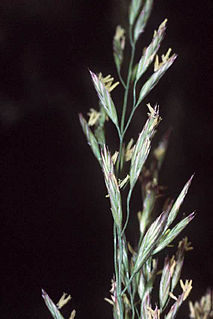
Festuca (fescue) is a genus of flowering plants belonging to the grass family Poaceae. They are evergreen or herbaceous perennial tufted grasses with a height range of 10–200 cm (4–79 in) and a cosmopolitan distribution, occurring on every continent except Antarctica. The genus is closely related to ryegrass (Lolium), and recent evidence from phylogenetic studies using DNA sequencing of plant mitochondrial DNA shows that the genus lacks monophyly. As a result, plant taxonomists have moved several species, including the forage grasses tall fescue and meadow fescue, from the genus Festuca into the genus Lolium, or alternatively into the segregate genus Schedonorus.

Distichlis spicata is a species of grass known by several common names, including seashore saltgrass, inland saltgrass, and desert saltgrass. This grass is native to the Americas, where it is widespread. It can be found on other continents as well, where it is naturalized. It is extremely salt tolerant.

Festuca rubra is a species of grass known by the common name red fescue or creeping red fescue. It is widespread across much of the Northern Hemisphere and can tolerate many habitats and climates. It is best adapted to well-drained soils in cool, temperate climates; it prefers shadier areas and is often planted for its shade tolerance. Wild animals browse it, but it has not been important for domestic forage due to low productivity and palatability. It is also an ornamental plant for gardens.
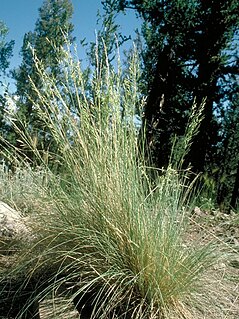
Festuca arizonica, commonly called Arizona fescue, is a grass found in western North America, in the southwest United States and northern Mexico. This species also has the common names mountain bunchgrass and pinegrass.

Festuca californica is a species of grass known by the common name California fescue.

Festuca idahoensis is a species of grass known by the common names Idaho fescue and blue bunchgrass. It is native to western North America, where it is widespread and common. It can be found in many ecosystems, from shady forests to open plains grasslands.

Festuca subulata is a species of grass known by the common names bearded fescue and nodding fescue. It is native to the northwestern quarter of North America, from Alaska to South Dakota to northern California, where it is most often found in moist mountain forests.

Festuca subuliflora is a species of grass known by the common name crinkleawn fescue. It is native to western North America from British Columbia to California where it is most abundant in the moist forests of the coastal mountains.

Festuca viridula is a species of grass known by several common names, including green fescue, greenleaf fescue, and mountain bunchgrass. It is native to western North America from British Columbia to Colorado, where it is most abundant in high-elevation forests and meadows.

Tussock grasses or bunch grasses are a group of grass species in the family Poaceae. They usually grow as singular plants in clumps, tufts, hummocks, or bunches, rather than forming a sod or lawn, in meadows, grasslands, and prairies. As perennial plants, most species live more than one season. Tussock grasses are often found as forage in pastures and ornamental grasses in gardens.
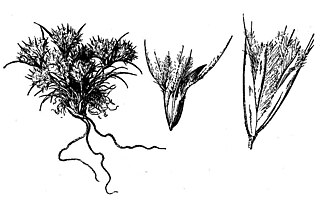
Blepharidachne kingii is a species of grass known by the common name King's eyelashgrass. It is native to the Great Basin in the United States, where it grows in habitat such as pinyon-juniper woodland. It is rare in California and Idaho, but it is one of the most common grasses of the northeastern deserts of Nevada.
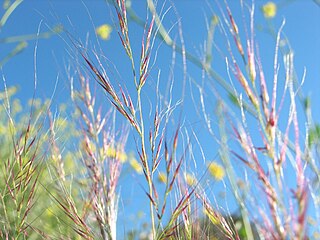
Vulpia microstachys is a species of grass known by the common names small fescue and small sixweeks grass. It is native to western North America from British Columbia to Colorado and New Mexico to Baja California, where it grows in many types of open habitat, including grasslands. It is dominant on some grasslands of California, and it was probably an abundant native grass before the habitat was altered by invasive non-native grasses. It occurs on serpentine soils with associates such as serpentine reedgrass. It is also known from parts of South America. It is an annual grass producing one stem or a clump of several stems growing up to 75 centimeters tall. The inflorescence has several open branches bearing clusters of purple-tinged spikelets. The spikelet has one to six flowers. The grass is usually cleistogamous, its flowers fertilizing themselves.
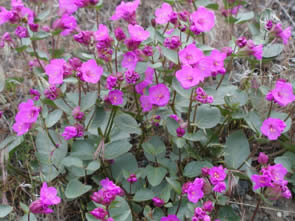
Mirabilis macfarlanei is a rare species of flowering plant in the four o'clock family known by the common name MacFarlane's four o'clock. It is native to Idaho and Oregon in the United States, where it is only known from three river canyons. It faces a number of threats and is federally listed as a threatened species of the United States.
Achnatherum richardsonii is a species of grass known by the common names Richardson's needlegrass, spreading needlegrass, and Canada mountain-ricegrass. It is native to northwestern North America, where it is distributed from Alaska and Yukon through the western Canadian provinces south to Colorado.

Achnatherum thurberianum is a species of grass known by the common name Thurber's needlegrass. It is native to the western United States, where it occurs from Washington to California and east to Montana and Wyoming.

Festuca thurberi is a species of grass known by the common name Thurber's fescue. It is native to a section of the western United States encompassing New Mexico, Utah, Colorado, and Wyoming. It probably also occurs in parts of Arizona.
Leymus innovatus is a species of grass known as downy ryegrass, boreal wildrye, hairy wildrye, fuzzyspike wildrye, northern wildrye, and northwestern wildrye. It is native to northern North America from Alaska to eastern Canada and south to Colorado.
Festuca ligulata is a species of grass known by the common name Guadalupe fescue. There is one population each in Texas and Coahuila.

Poa fendleriana is a species of grass known by the common name muttongrass. It is native to western North America, where its distribution extends from western Canada to northern Mexico.


















